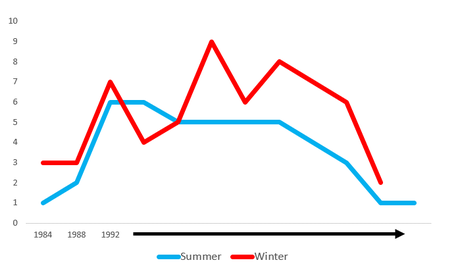The 2018 Winter Olympics closed in Pyeongchang, South Korea in the early hours of this morning to much fan fare. The ceremonial event involved the passing of the Olympic Torch to Beijing where the 2022 Winter Games will take place. Beijing will host its second Olympics in 14 years, following on from the Summer Games in 2008.
Much has been written on this blog about the hosting of major sporting events and the costs involved. In a previous post, I also addressed the number of bidders prior to the voting for the Summer Games. Not surprisingly, given the costs involved there has been a gradual decline in the number of bidders, from a high point in the 1990s, to more recent times. The graphic below presents the number of bidders for both the Summer and Winter Games from 1984 to the Summer Games in 2028.

Since the start of this decade there has been a consistent decline in the number of bidders for both sets of Games. The Winter Games has seen a fall from 8 in 2010, to 7 in 2014, to 3 in 2018, to just 2 for the 2022 Games.
The Summer Games went one step further when Paris and Los Angeles effectively agreed to let each other have a solo run at the 2024 and 2028 Games respectively.
While the destination of the 2026 Winter Olympics will not be known until the 134th International Olympic Committee Session in Milan, Italy during September 2019, it will be interesting to see if all four potential hosts currently suggesting they will be, will actually do so. If Sion, Sapporo, Stockholm and Calgary all do, they will buck the recent trend in host bidding.
 RSS Feed
RSS Feed